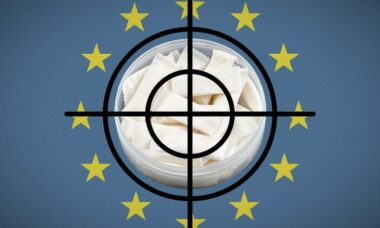 As Europe tightens its grip on disposable vapes with bans and restrictions addressing environmental and public health concerns, attention is beginning to shift to another rapidly growing nicotine product: nicotine pouches.
As Europe tightens its grip on disposable vapes with bans and restrictions addressing environmental and public health concerns, attention is beginning to shift to another rapidly growing nicotine product: nicotine pouches.
These smoke-free alternatives have gained popularity among consumers seeking to avoid traditional smoking and vaping. However, as their use rises, important questions emerge about whether nicotine pouches could soon face heightened scrutiny and regulation.
A major concern is the growing appeal of nicotine pouches among younger demographics. Similar to disposable vapes, pouches are often packaged in sleek, eye-catching designs and come in a variety of enticing flavours such as mint, berry and citrus. Critics argue that these features make them especially appealing to teenagers and young adults, potentially leading to nicotine addiction in groups that might otherwise avoid tobacco products. Public health organisations across Europe have begun raising alarms about the marketing tactics used to promote nicotine pouches, drawing comparisons to the controversies surrounding disposable vapes.
Another key issue is the lack of consistent regulation for nicotine pouches across the European Union. As a relatively new product, pouches have often fallen through regulatory cracks. In some countries they are classified as food products, while others treat them as medicinal or tobacco items. This fragmented approach creates confusion for manufacturers, consumers and regulators alike. As the market for nicotine pouches grows, there is an increasing recognition of the need for harmonised regulations to address these inconsistencies and ensure responsible oversight.
Pouches can have an environmental impact
Environmental concerns also warrant attention. While nicotine pouches do not generate the same volume of waste as disposable vapes, for example, they are still a single-use product. Typically made of synthetic fibres and chemical additives, nicotine pouches can contribute to microplastic pollution if not disposed of properly. Furthermore, the packaging, although less excessive than that of vaping products, is another area being scrutinised by environmental advocates. As European governments continue to prioritise sustainability, stricter rules on the materials used in nicotine pouches or even bans on certain types of packaging may become part of the conversation.
Looking ahead, the future of nicotine pouch regulation may follow a path similar to the one set by disposable vape bans in countries like Belgium and France. Governments may impose restrictions on flavours to reduce the appeal of pouches to young users and require clearer, more prominent labelling to warn of the health risks associated with nicotine. Some countries are proposing such low thresholds of nicotine content as to lead to their ban, such as in Luxembourg (0.048 mg per pouch) and Spain (0.99 mg per pouch).
Former French minister of health Geneviève Darrieussecq indicated in an October 2024 interview that the government plans to ban nicotine pouches and other oral nicotine products as a measure to protect youth. Catherine Vautrin, who currently holds the position, has not yet shared her views on nicotine pouches but recently advocated for the swift implementation of the disposables ban. Representing a centrist government, her positions are likely to align closely with those of her predecessor.
Action recommended to avoid becoming a regulatory target
Tax increases on nicotine pouches could also be a possibility, bringing their cost closer to traditional tobacco products in order to deter use among price-sensitive groups, such as teenagers. Additionally, EU environmental initiatives may prompt the introduction of mandates for recycling programmes or biodegradable materials in the production of nicotine pouches.
The core question remains whether policy-makers will see nicotine pouches as part of the problem or part of the solution. Advocates of harm reduction stress the value of nicotine pouches as a safer alternative for smokers attempting to quit, warning that excessive restrictions could stifle innovation and push consumers back towards more-harmful products like cigarettes. On the other hand, failing to implement effective regulations could allow nicotine pouches to perpetuate addiction cycles, particularly among younger, non-smoking users drawn to their convenience and flavours.
The EU’s response to the disposable vape crisis demonstrates that regulators are willing to take decisive action when environmental and public health concerns intersect. If nicotine pouches continue to rise in popularity, especially among younger users and non-smokers, they may become the next target of regulatory action.
Industry members would be wise to take a proactive stance, learning from the vaping sector’s mistakes by addressing environmental, marketing and health concerns before stricter measures become inevitable. This approach could help strike a balance between providing smokers with a viable alternative and meeting the growing demand for sustainability and public health accountability.
– Antonia Di Lorenzo TobaccoIntelligence staff
Photo: Stefan Schweihofer, Rob Grant







